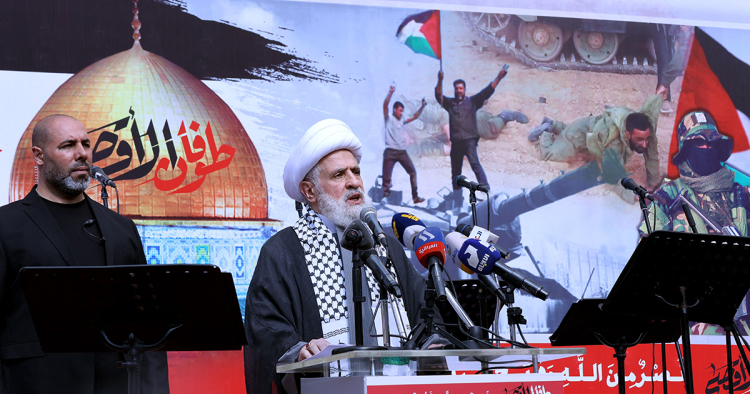Since the Hamas attack on Oct. 7, regional and extra-regional actors have been working to prevent an expansion of the conflict beyond the Gaza-Israel theater, focusing particularly on the Lebanese-Israeli border. The United States sent two aircraft carriers to the eastern Mediterranean primarily as a deterrence message to Iran and Hezbollah.
A decision by Hezbollah to enter the ongoing war would open a second front and bring into the fight their large arsenal of rockets and precision-guided missiles capable of hitting critical Israeli infrastructure. It would also bring destruction to Lebanon while the country reels from a severe economic crisis.
The Lebanese caretaker prime minister, Najib Mikati, has already announced he has not been given guarantees by Hezbollah leadership that they will not engage in this fight once the Israeli ground invasion of Gaza starts.
Since 2006, a mutual understanding of the rules of the game has been in place between Hezbollah and Israel to govern their conflict. When these rules were violated, a limited tit-for-tat escalation followed, but soon thereafter, indirect negotiations mediated by the United Nations Interim Force in Lebanon (UNIFIL) led to a restoration of the status quo ante.
Since Oct. 7, we have been witnessing a slow and steady degradation of these rules. Hezbollah’s spokesperson, Rana Sahili, notably referred to the increased intensity in cross-border fire exchanges — which led to the death of three Hezbollah militants, a Lebanese journalist, and two civilians by Israeli shelling and the death of an Israeli soldier in a Hezbollah cross-border missile attack — as “only skirmishes” and representing a “warning” to Israel. A statement issued by the militant group, following Hezbollah Secretary-General Hassan Nasrallah’s meeting with Iranian Foreign Minister Hossein Amir Abdollahian in Beirut, stressed “the responsibilities of each person and the positions to be taken in the face of these historic events and these dangerous developments.” Last Friday, Hezbollah’s Deputy Secretary-General Naim Qassem said the attempts at outreach by “major countries, Arab countries, and envoys from the United Nations, directly and indirectly, asking us not to interfere in the battle, will not affect us.”
We have entered uncharted territory primarily because the Israeli objective for their ground operation in Gaza is different from previous Israel-Hamas wars, in 2008, 2012, 2014, 2018, and 2021. The last of these went on for 11 days and killed at least 250 people in Gaza and 13 in Israel before ending with a truce between Hamas and Israel.
Since Hamas’ takeover of Gaza in 2007, the group has been a useful tool for Israel to continue to deny Palestinians a path to statehood, claiming that the division within the Palestinian leadership, between an increasingly weak Palestinian Authority in the West Bank and a terrorist entity ruling Gaza, leaves Israel without a representative Palestinian interlocutor to negotiate with.
But following its attack a little over a week ago, Hamas’ usefulness as a tool for the Israeli government to divide and conquer the Palestinians has seemingly run its course. According to different statements by Israeli military officials, the objective of the looming Israeli operation in Gaza is to destroy Hamas’ military infrastructure, kill its leadership, eviscerate the group’s weapons manufacturing facilities, and deny it the ability to reconstitute its rule over Gaza.
These objectives collectively represent a red line for Hezbollah. Since April 2023, Hezbollah and Hamas leaders have been talking about a unification of fronts, meaning any attack that aims at targeting the other’s political and physical survival, will engender a wider conflict. During previous Hamas-Israel wars, Hezbollah did not entertain the possibility of widening the scope of the conflict, mainly because Israel’s goal then was not to remove Hamas from the Gaza Strip. Therefore, Hezbollah’s escalation calculus about a regional war differs dramatically this time.
In entertaining the option of opening a second front, four principal questions will be key in internal Hezbollah discussions:
- Can Israel achieve its objective of eradicating Hamas’ military and political infrastructure in the Gaza Strip, including the assassination of the key leadership?
- How deep and bloody will the Israeli military offensive in the Gaza Strip be?
- How credible is the U.S. threat? If Washington gets involved, what will be its likely targets in Lebanon, and how long will it maintain its offensive operations?
- How would a multi-front war affect public opinion in the region and abroad?
The closer Israel gets to achieving its stated objectives in Gaza, the higher the death toll there, the less credible the U.S. threat, and the more positively that Arab public opinion begins to view a multifront war against Israel, the more likely Hezbollah will opt for a military escalation on the Lebanese-Israeli border.
Randa Slim is the Director of the Conflict Resolution and Track II Dialogues Program at the Middle East Institute and a non-resident fellow at the Johns Hopkins University School of Advanced and International Studies (SAIS) Foreign Policy Institute.
Photo by ANWAR AMRO/AFP via Getty Images
The Middle East Institute (MEI) is an independent, non-partisan, non-for-profit, educational organization. It does not engage in advocacy and its scholars’ opinions are their own. MEI welcomes financial donations, but retains sole editorial control over its work and its publications reflect only the authors’ views. For a listing of MEI donors, please click here.













